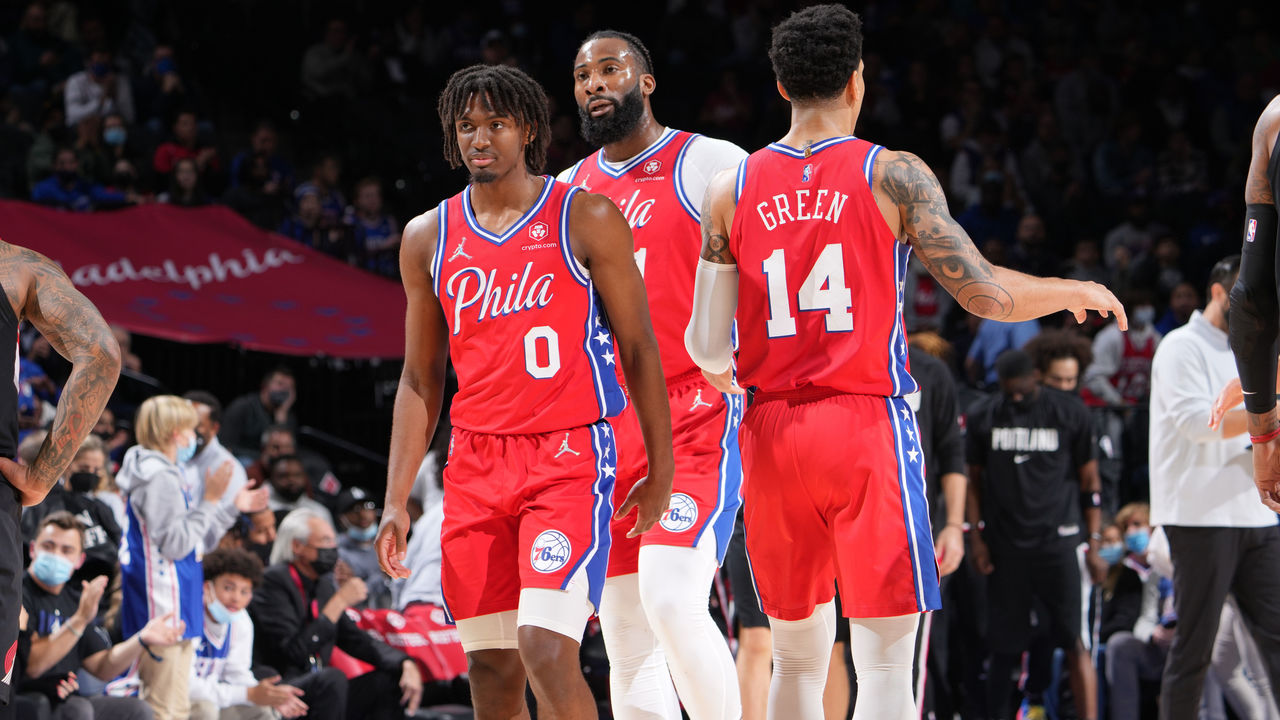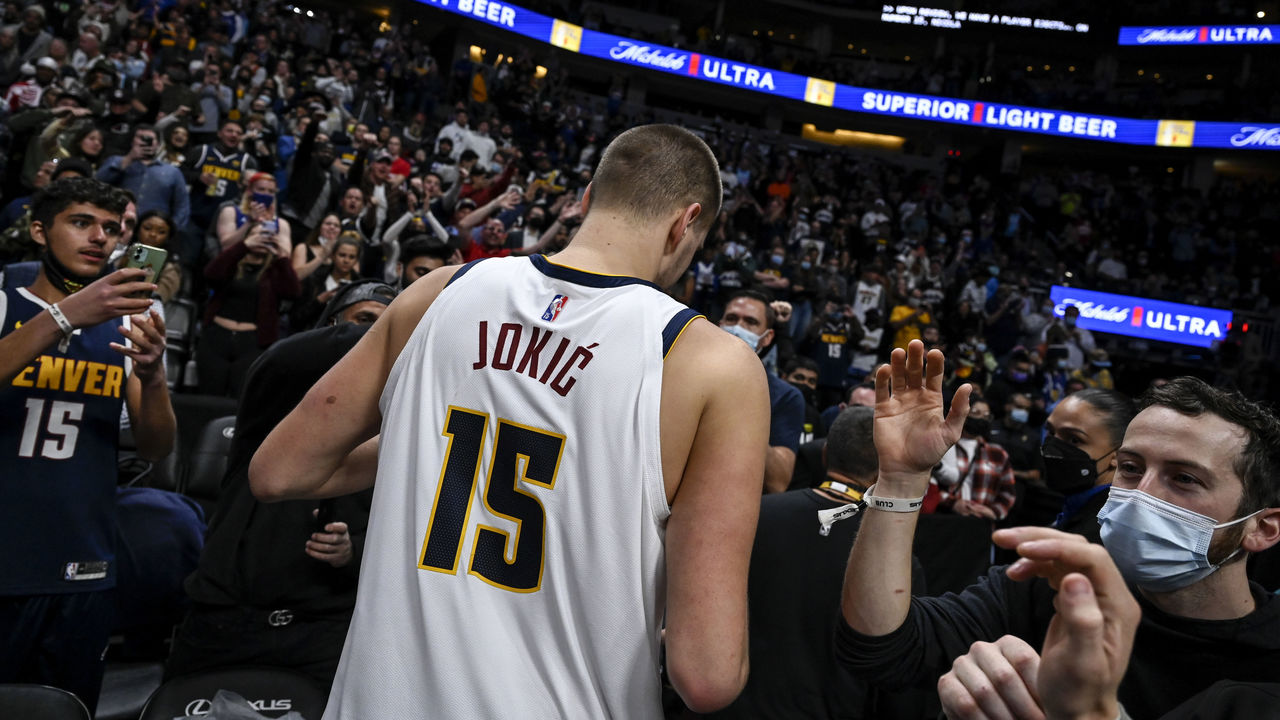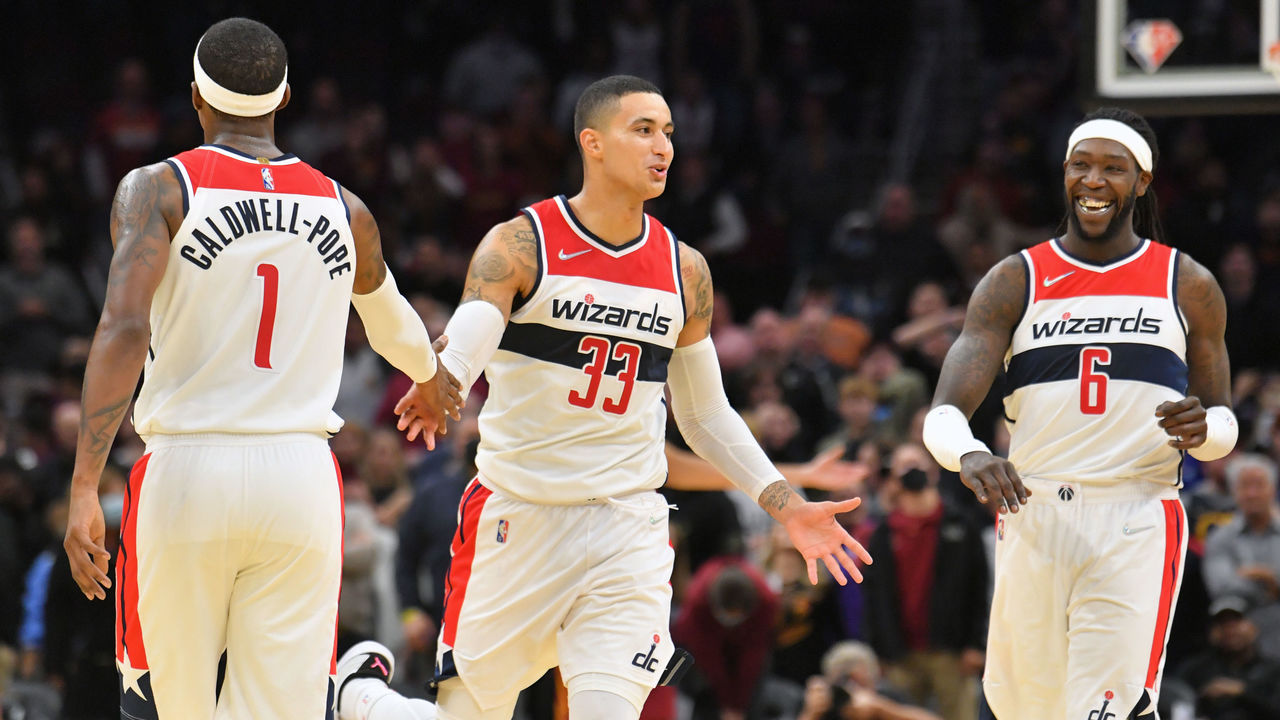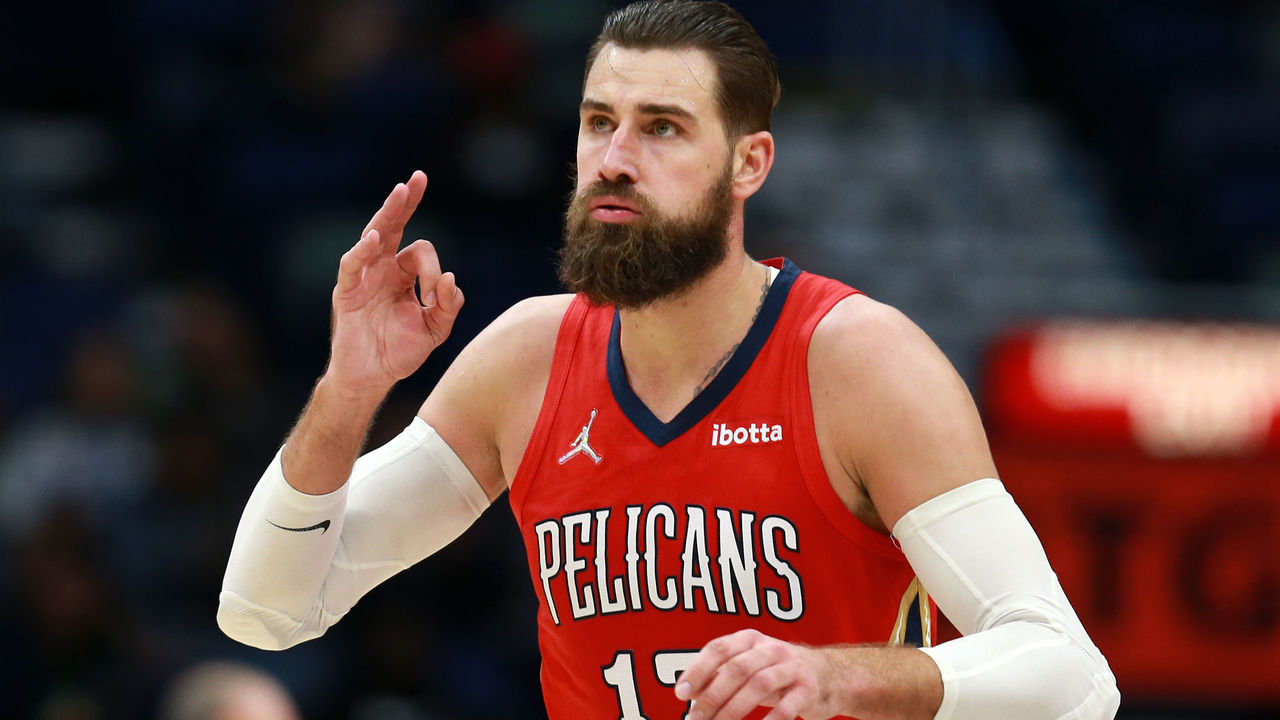Fun with small sample sizes: Can these early trends be signs of what's to come?
The NBA's 2021-22 season is still new enough to provide an opportunity for fun with small sample sizes, but it's also deep enough into the schedule where we can consider whether these early-season trends might be bigger indications of what's to come.
Here are six of those trends to monitor:
Philly winning the Embiid-less minutes

One of Philadelphia's most fatal flaws in recent years has been the way it craters without Joel Embiid on the court. Sure, issues related to offensive initiation and general guard play have hurt the 76ers, but even with Jimmy Butler in the fold a few years ago, the Sixers were outscored by 109 points in their 99 Embiid-less minutes over their seven-game loss to Toronto.
Philadelphia hasn't been as terrible as that when Embiid's been on the bench during the regular season - it actually posted slightly positive numbers without him in each of the previous two years - but the team's never been better without Embiid than its been through nearly a month of this season (plus-1.8 points per 100 possessions in 394 Embiid-less minutes).
There's also reason to believe it might be more sustainable and postseason-proof this time.
For one, Philadelphia is doing this without even a minute's worth of contribution from Ben Simmons, and you'd have to imagine the Simmons saga will be resolved by the time the playoffs roll around. It would be shocking if the Sixers entered a postseason in the middle of Embiid's prime without Simmons or players acquired via a Simmons trade.
Secondly, Andre Drummond has provided exactly what Philly desperately missed in previous years when Embiid sat. The veteran center won't produce the same kind of offense as Embiid, but Drummond has been capable enough defensively and on the glass - while showing off his underrated playmaking vision - to keep the Sixers solid when the team's MVP isn't on the court.
Philadelphia is currently one of only eight teams winning both starter-majority minutes and reserve-majority minutes.
An unheralded quartet of guards may not be able to keep this up all season in Philly, but there's evidence within the Sixers' opening month that shows they can at least tread water when Embiid needs a breather come playoffs.
The Joker's 🐐 season

Nikola Jokic would have to usurp his prolific 2020-21 performance while keeping a Jamal Murray-less - and now Michael Porter-less - Denver Nuggets team near the top of the Western Conference standings if he wants to repeat as NBA MVP.
Check and check through nearly a fifth of the new season.
Jokic isn't just one-upping his MVP campaign. He's authoring the opening chapters of what might be the greatest single-season performance we've ever seen.
Denver's big man is averaging 26.1 points, 13.8 rebounds, 6.3 assists, 1.3 steals, and 0.9 blocks on 66.5% true shooting. No player has ever averaged 26, 13, and six in a season. Jokic also leads the league in every conceivable advanced or all-purpose metric while on pace to post an all-time PER so ludicrous that you have to see it to believe it.
Nikola Jokic currently has the highest single-season PER of all time. And it’s not close.
— StatMuse (@statmuse) November 15, 2021
The gap between him (35.1) and the second player (Wilt Chamberlain at 32.1) is bigger than the gap between Wilt and the 45th player. pic.twitter.com/dswUcE5rf1
When he's on the court, nearly 31% of Nuggets possessions end with the ball in his hands, and almost 34% of his teammates' made field goals come off Jokic assists. He's also playing the best defense of his career, and a battered Nuggets team still owns a top-four record in the West.
Denver boasts a robust net rating when Jokic is on the court (plus-14.2) that is 1.5 points per 100 possessions better than Golden State's overall league-leading mark. When The Joker sits, the Nuggets' net rating (minus-11.1) is half a point worse than the 30th-ranked Rockets. He is value defined.
It seems improbable that any player can do for an entire season what Jokic has done through four weeks, but everything about the Serbian big man's basketball journey, appearance, and NBA career suggests if anyone can make the impossible possible, it's him.
The Wizards ... playing defense?!

It's not just that the Wizards have the Eastern Conference's best record that's shocking. It's that Washington owns the East's best defense and the fourth-ranked defense league-wide after finishing 20th, 29th, and 27th on that end in the last three seasons.
It's hard to overstate how much of a coup the five-team Russell Westbrook trade was for the Wizards, who acquired Spencer Dinwiddie, Montrezl Harrell, Kyle Kuzma, Kentavious Caldwell-Pope, and Aaron Holiday (plus Isaiah Todd) in the blockbuster.
Caldwell-Pope, Kuzma, and Holiday, especially, have helped turn things around defensively, but even Harrell's looked more comfortable on that end than ever before. Starting center Daniel Gafford has been the team's defensive anchor, while sophomore Deni Avdija has competed admirably.
Rookie coach Wes Unseld Jr.'s aggressive scheme has limited opponents' shots at the rim and from deep while forcing them to take more mid-range attempts than any other team.
The fact that Washington's defense has actually been more than three points per 100 possessions stingier when Bradley Beal is on the court is a sign there's still some noise in these early numbers. Even if the Wizards aren't this good defensively, they're a helluva lot better than they've been in a long time.
Given the team's improved depth (3-0 without Beal this season) and overall firepower when Beal's in the lineup, the Wizards have staying power in the top half of the East if they defend anywhere near this well for the remainder of the season.
Knicks, Magic starters stunning for different reasons

One is a playoff team led by star names looking to build on a top-four seed earned last season. The other is a star-less, young squad expected to jostle for the league's worst record. The former is supposed to be able to at least compete with the league's best lineups, while the latter should theoretically be getting its doors blown off in those starter-heavy minutes.
Yet when you examine the most used lineups through nearly a month of the season, you'll find that the opposite is true.
Of the 30 most used lineups thus far, only the lowly Rockets and Thunder play groups who have performed worse than the Knicks' starting quintet of Kemba Walker, Evan Fournier, RJ Barrett, Julius Randle, and Mitchell Robinson (minus-16.2 points per 100 possessions). On the other end of the spectrum, Orlando's starting five of Cole Anthony, Jalen Suggs, Franz Wagner, Wendell Carter, and Mo Bamba - with an average age of just 21.2 - boasts a net rating (plus-15.4) only bested by two of the 30 most played groups. (Thankfully for the Knicks, the best-performing quintet thus far is New York's all-bench lineup).
The truth lies somewhere in the middle, as the Knicks' starters can't possibly be this bad, and the Magic's youthful unit can't perform this well all year. But both could be harbingers of what's to come.
New York rode some shooting luck (on both ends) to its surprising 2020-21 campaign. The team's overall talent base improved this season but took a massive step back defensively while the Eastern Conference got deeper than it's been in a quarter-century. Regression to the mean is hitting the Knicks hard. Even if they're better than this, the performance of the team's supposed best five is a rude reminder that this club isn't competing for anything of significance come April, May, and June.
The Magic, meanwhile, can take solace in the fact their young players are teasing the ability to compete with the NBA's best while still losing enough games in the short term to ensure they'll be in the mix for another potential franchise-changer in the 2022 draft.
Anthony looks like one of the league's most improved players, Wagner appears to be one of its most impressive rookies, and Bamba finally looks like an NBAer. Additionally, the Magic still have Jonathan Isaac's and Markelle Fultz's returns to look forward to.
Orlando's accumulating the type of young talent that has you looking at the standings in a year or two and wondering how the hell it got so good, so fast.
Sweet shooting bigs

A previously limited big man letting it fly from deep is no longer a stunning development in the modern NBA, but there are a few bigs shooting the lights out to keep an eye on.
First and foremost is Jonas Valanciunas. Though the nine-year veteran had shown range and willingness in recent years, he still entered this campaign hitting fewer than 100 career threes, and he never averaged more than 0.5 made triples per game in a season. However, Valanciunas leads the league in 3-point shooting this campaign, converting a preposterous 59.3% of his modest yet decent sample size of attempts. He's also averaging 1.1 made three per game this season.
Is Valanciunas really going to have the greatest shooting season of all time? No. But can his improved range help space the floor when Zion Williamson returns to the Pelicans' frontcourt? Absolutely.
The other hot-shooting bigs to monitor are Myles Turner and Wendell Carter.
Turner's been a fairly average (35.2%) 3-point shooter throughout his career, but the defensive stalwart is finally making good on his promise as a 3-and-D center, knocking down better than 43% of his 4.5 attempts per game. Whether it makes him a better fit for frontcourt partner Domantas Sabonis or a more attractive trade chip for a team one big away from contention, Turner becoming the type of rarity who can protect the rim on one end while consistently stretching the floor on the other is a major development.
Carter made just 27 total treys and shot 24% from deep through his first three seasons. In 14 games this campaign, the 22-year-old has made 25 threes while shooting 46% from long range. The Magic already have a ton of frontcourt length and defensive upside, but Carter popping as a stretch-big ups the long-term ceiling for both team and player.
Refs not having it

The rule change geared toward eliminating non-basketball movements by offensive players hunting for fouls has been one of the most heated early-season topics among players.
The players who used to benefit most from bamboozling officials - James Harden, Trae Young, Luka Doncic, Damian Lillard, Bradley Beal, etc. - are visibly and audibly frustrated. Defensive-minded players like Draymond Green, meanwhile, are infatuated with the new-look Association.
With more than 17% of the 2021-22 schedule completed, the league-average free-throw attempt rate stands at an all-time low of 22.1 free-throw attempts per 100 field-goal attempts. A decrease in shooting fouls on long jumpers is the biggest culprit.
What's worth monitoring going forward is whether refs can find a balance between continuing to cut the cheap stuff out of the game while getting back to calling legitimate fouls more consistently. No one wants to watch 48 minutes of flopping and flailing, but the last thing the league needs is to teleport back to the ugly, grinding ball of the late '90s and early 2000s, which itself led to rule changes banning hand-checking and encouraging more freedom of movement.
Given the way refs often hammer home the league's points of emphasis early in the season before letting things breathe as the year wears on, we should have faith the perfect middle ground will be found.
Joseph Casciaro is theScore's senior basketball writer